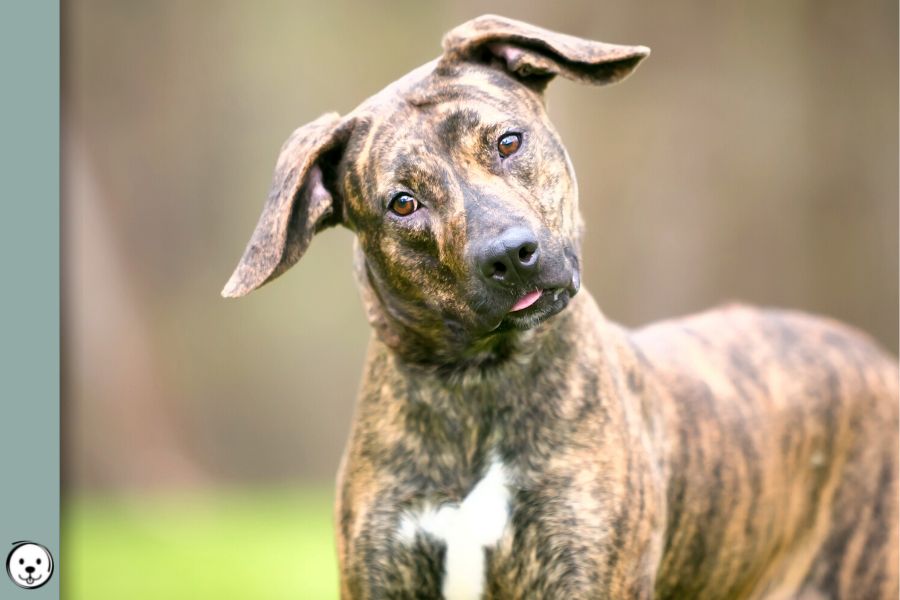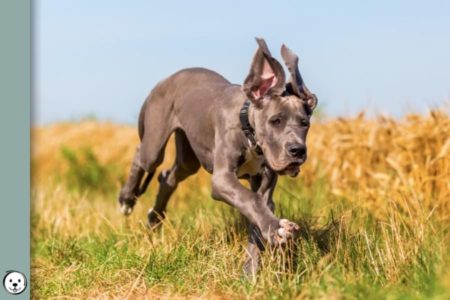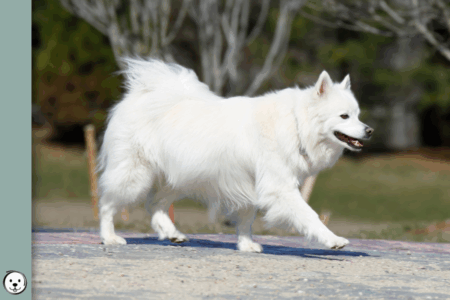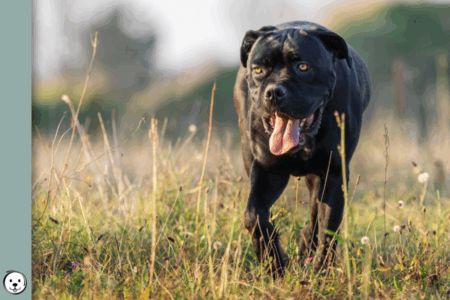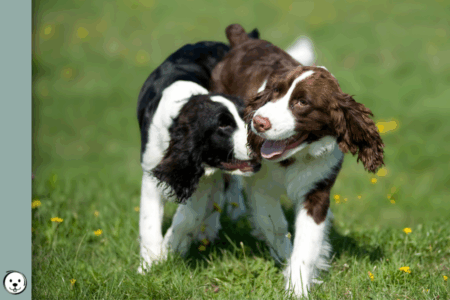Brindle (kbr) is a pattern that causes black stripes on a red base color. Here we look at the variations and genetics of brindled coats in dogs.
What is Brindle?
Brindle can only happen in dogs that express any of the A-Locus patterns with visible red pigment (clear sable, shaded sable, agouti, saddle back, creeping tan, or tan point).
Brindle adds random vertical stripes of eumelanin-pigmented coat running from top to bottom over the red base color with visible phaeomelanin. Learn more about pigment types here.
While brindle stripes often seem quite irregular, they often follow some basic direction with a V-shape along the back and stripes running vertically and loosely following the shape of the body.
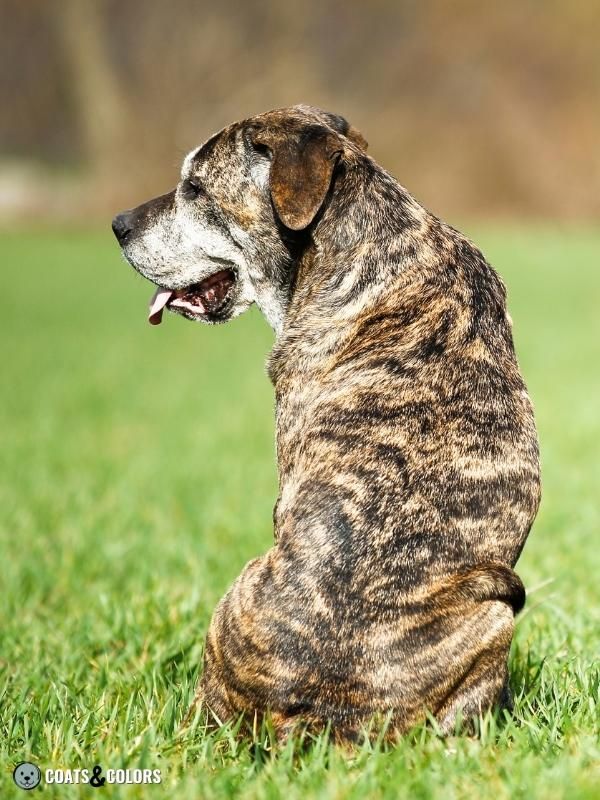
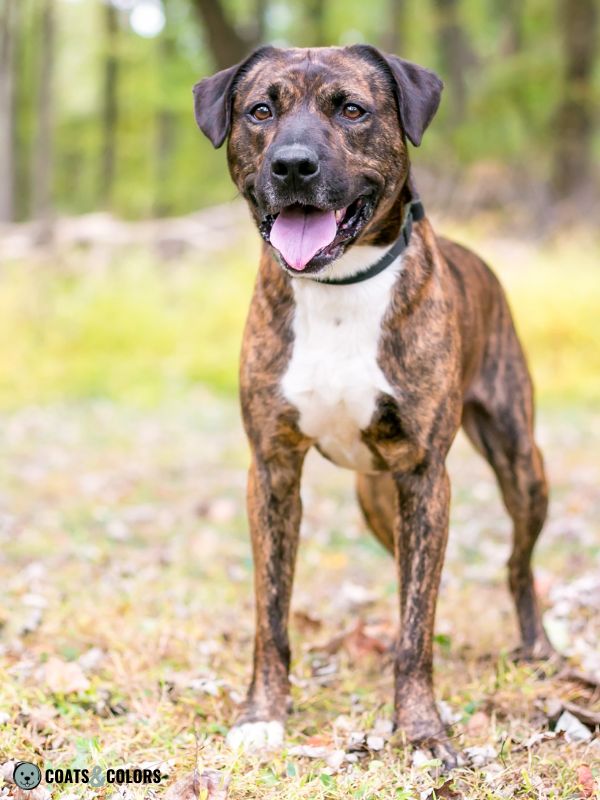
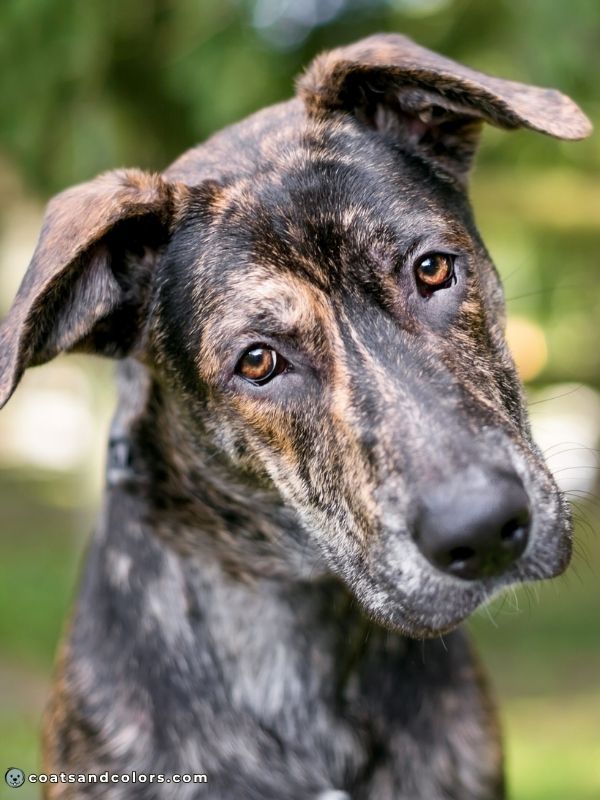
Both eumelanin and phaeomelanin are visible in a brindle pattern.
Many traits that affect these pigments such as merle, graying, color dilution, liver, white spotting, ticking, intensity, or countershading can change how a brindled dog actually looks.
And there might also be some yet unknown modifiers that affect the expression of different brindle patterns. Brindle density varies greatly from barely visible striping to very, very dense striping.
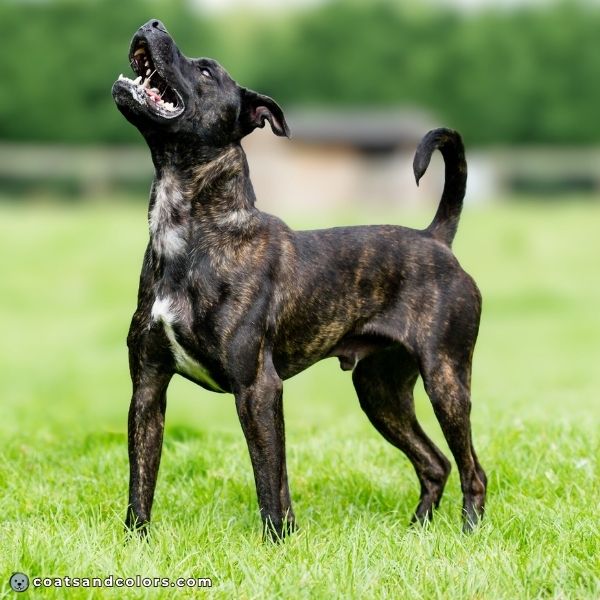
Breeds often name brindle patterns after their predominant color.
They might call a dog with dense striping a “black brindle” and dogs with less intense striping a “red brindle” or “fawn brindle“. Dogs that show an unusually dense or unusually sparse brindle pattern for their breed may be called “reverse brindle” (this term can mean different things in different breeds).
The kbr-Allele
There are three alleles at the K-Locus: KB (dominant black), kbt (brindle), and ky (normal expression).
The wild-type allele ky causes normal production of eumelanin and phaeomelanin in all patterns. The dominant allele KB causes a dominant black coat with only eumelanin.
kbrindle is recessive to KBlack but dominant over kyellow. The kbr allele causes a mix between these phenotypes with stripes of eumelanin on top of all areas with visible phaeomelanin.
kbr causes a somewhat random variegated expression of the KB phenotype.
And this is hardly surprising if we consider that the kbr variant orignated from a recombination event between a KB and a ky allele. The brindle allele happened due to a duplication of the K locus where somehow at least one copy of KB and one of ky ended up next to each other on the same chromosome.
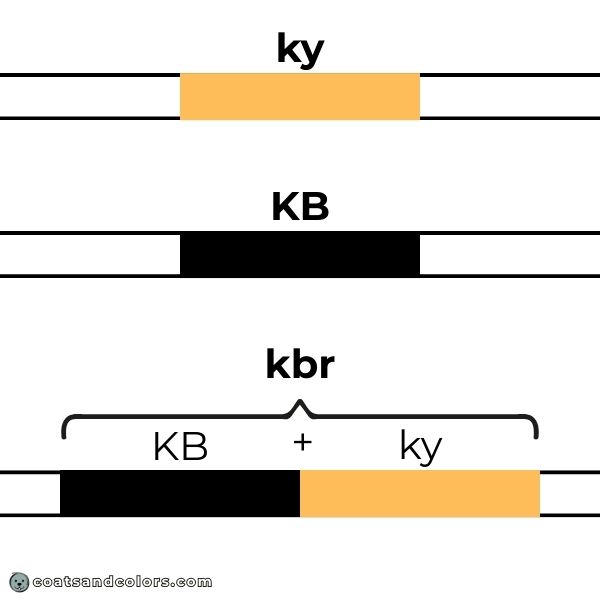
This is also why dogs with kbr always test as KB/ky (even when a dog is actually KB/kbr, kbr/kbr, or kbr/ky). Only very few companies (e.g. Laboklin) can reliably detect the kbr variant.
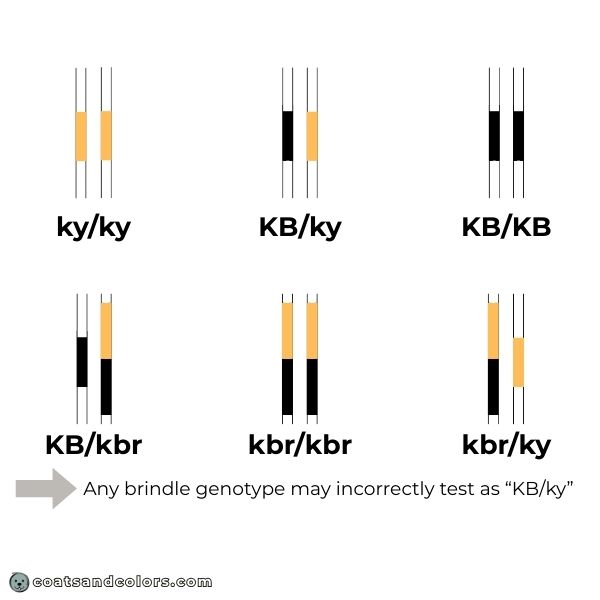
And since brindle is already present in breeds of ancient origin like Akita, Shiba, and other Asian spitz breeds the first brindled dog likely lived several thousand years ago. Today, brindle is found in dogs from all breed groups like Dachshund, Mastiff, Irish Wolfhound, or Cairn Terrier.
The brindle stripes give us a clue about the pathways the pigment cell precursors (melanoblasts) traveled across our dog’s body. During embryonic development, they migrate from the neural crest along the body all the way to the extremities. And in brindle dogs, some cells produce a solid black coat (KB) and some produce a solid yellow coat (ky) thus creating a striping pattern.
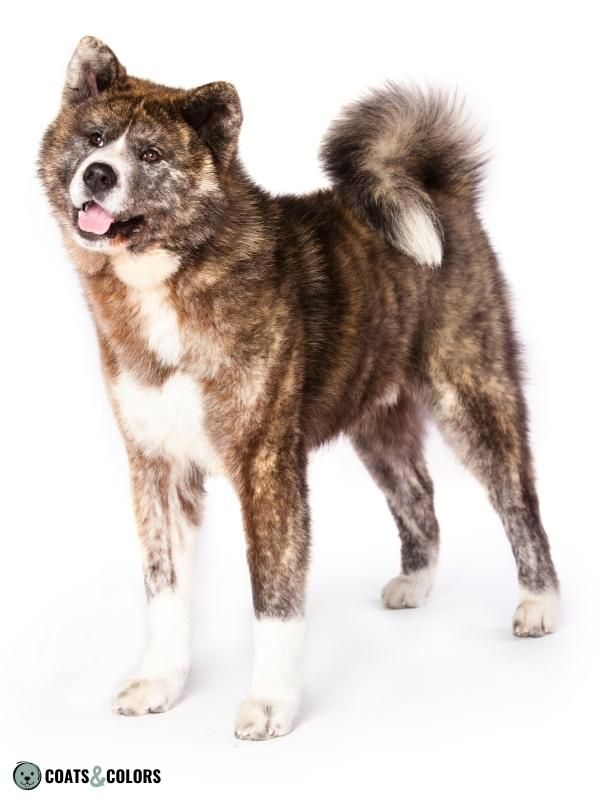
Genetics of Brindle Density
There seems to be more to brindle than we currently understand. Newer research by Vetgenomics Russia from 2023 indicates that brindle alleles can change between generations.
At present, most of these ideas are still very speculative.
However, if they are confirmed, they could explain some strange observations that breeders have made over the years. But hopefully, they will help to develop a test method for brindle density.
During the formation of germ cells, there is some pairing and reshuffling of homologous sequences between chromosomes, called recombination.
Brindle is a fusion of a KB and a ky (KB+ky = kbr). During recombination, a brindle allele might lose one of these sequences and may in some super rare cases revert back to either KB or ky. Actually, there seem to be at least a few known cases of kbr/- dogs producing solid black offspring with a ky/ky partner. Meaning, some dogs that are visibly kbr/- seem to pass on a surprise KB to their offspring…
This sounds very far-fetched, I know. And I have yet to see one of those cases where genetic testing confirmed parentage to rule out a sneaky KB/- sire involved in producing a puppy like this.
Far more interesting are the findings about brindle density:
Recombination can also produce brindle alleles with more than one copy of KB (KB+KB+ky = kbr+). And kbr+ brindle alleles can also sometimes revert back to having less KB copies.
And these additional copies of KB inside the brindle allele may explain darker brindle patterns.
All of this would explain how breeders can easily select for extra-dark brindle coats (unknowingly selecting for kbr+ over kbr). Or how some offspring may get an unusually light or dark pattern compared to the rest of the breed (when kbr turned into kbr+ or kbr+ reverted to kbr).
When will a dog be brindled?
To have a brindle pattern with alternating stripes of eumelanin on phaeomelanin, a dog has to be able to produce both types of pigment and to switch from one to the other.
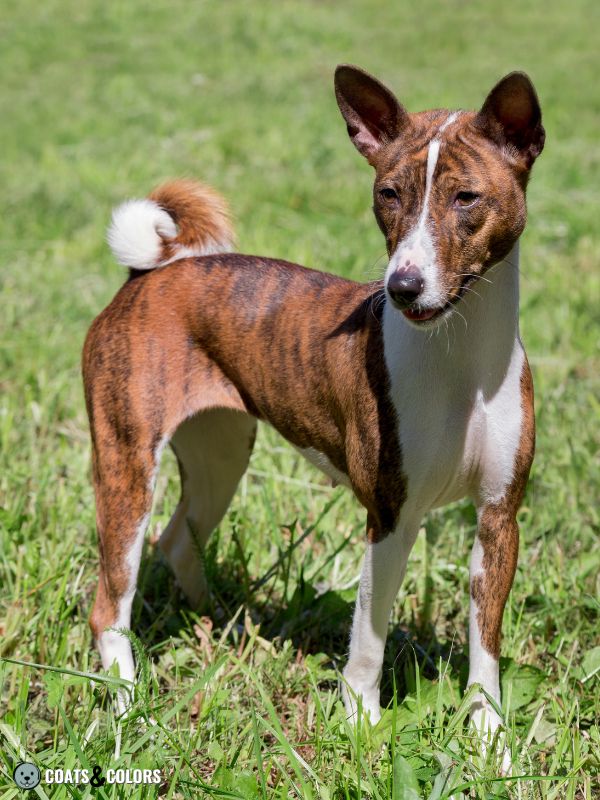
So brindle won’t be expressed in dogs that are either recessive red (e/e, phaeomelanin only), dominant black (which would be KB/kbr anyway), or recessive black (a/a, eumelanin only).
And of course, the coat has to be pigmented at least in some areas. If a dog is all white e.g. due to being extreme piebald or whitehead, you can’t observe their brindle pattern.
Brindle Patterns
Brindle can affect different ASIP patterns and can itself be affected by a variety of different genes, explaining the many different looks on brindle dogs!
Brindle Density
The brindle pattern in some dogs is very minimal with only some sparse stripes here and there.
Minimal brindle can be found in many breeds from Great Danes to Bulldogs. It seems to be especially common in sighthound breeds like Whippet, Galgo Español, or Greyhound.
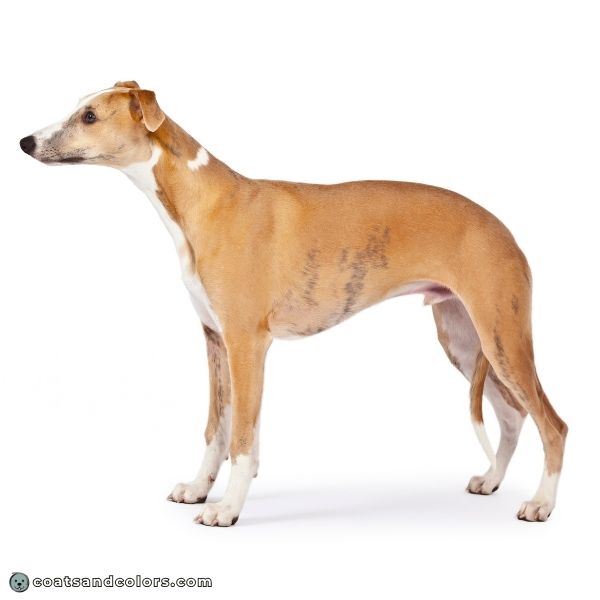
But brindle can also get very heavy up to the point where the dog looks almost completely black.
Since a very dense striping pattern gives the impression the dog had actually red stripes on black coat this is sometimes called black brindle or reverse brindle.
But there is no such thing as “red striping”. All brindle dogs express black stripes on top of red.
Very black brindle can be found in many breeds like French Bulldog, Boston Terrier, Boxer, Cairn Terrier, or Kai Ken. Very dark brindle patterns are often accompanied by extended black masks.
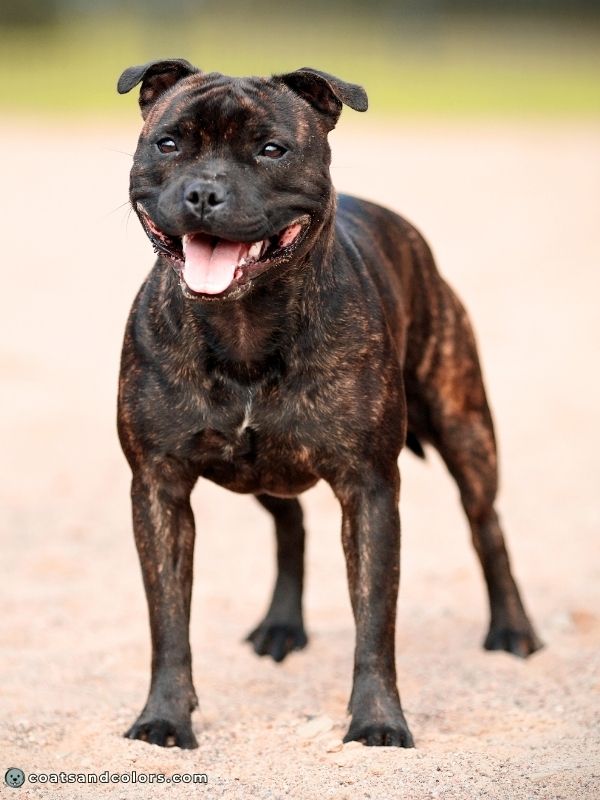
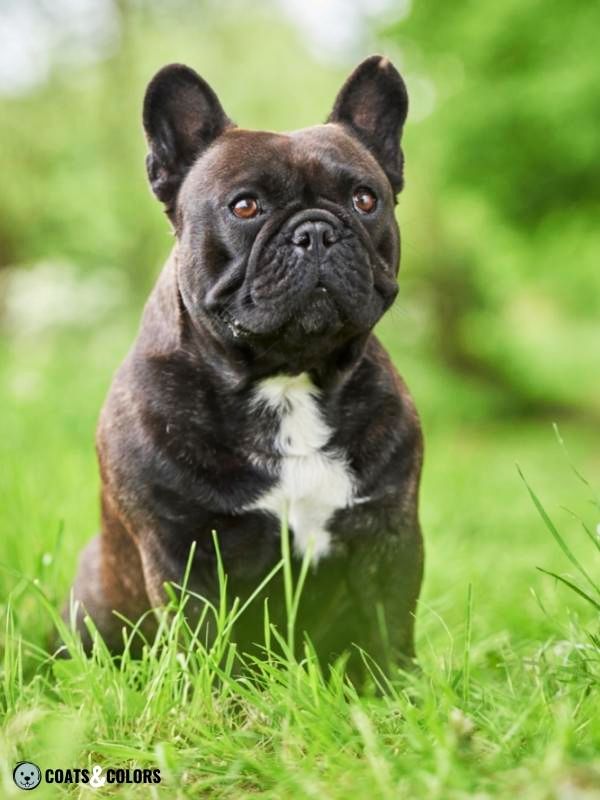
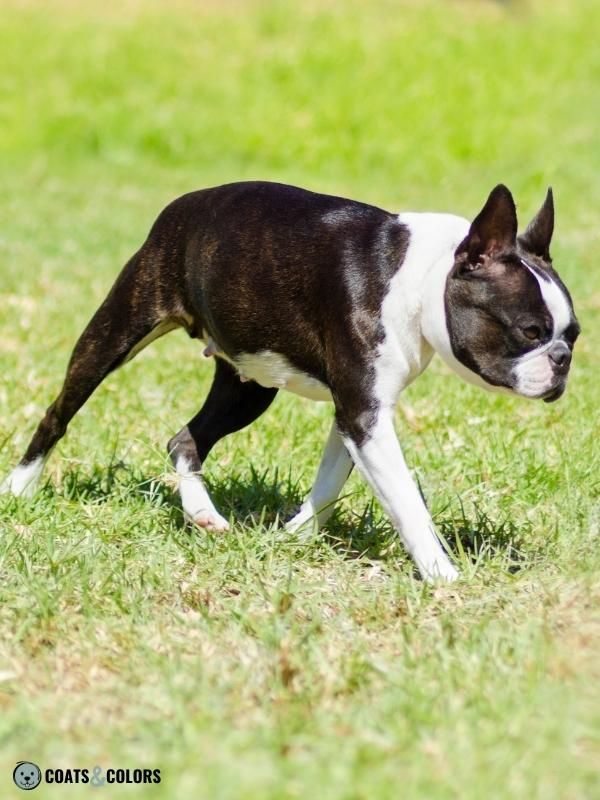
Brindle and Coat Types
The distinct stripes in brindle patterns can be seen most clearly in short-haired dogs. But of course, many breeds with very different coat textures can sport a brindle pattern.
The brindle pattern on wire-haired, furnished, curly, or long-haired dogs is less visible. It often causes a fuzzy pattern with darker and lighter areas that seem to blend into one another.
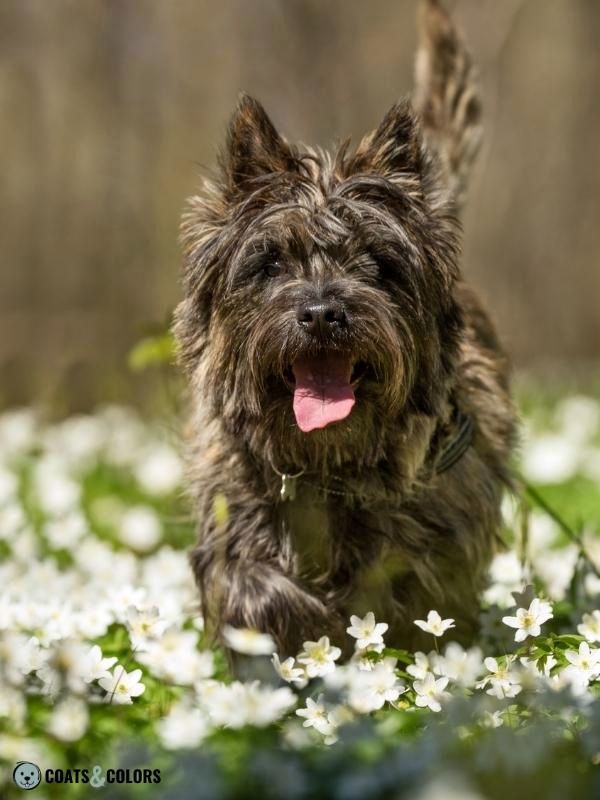
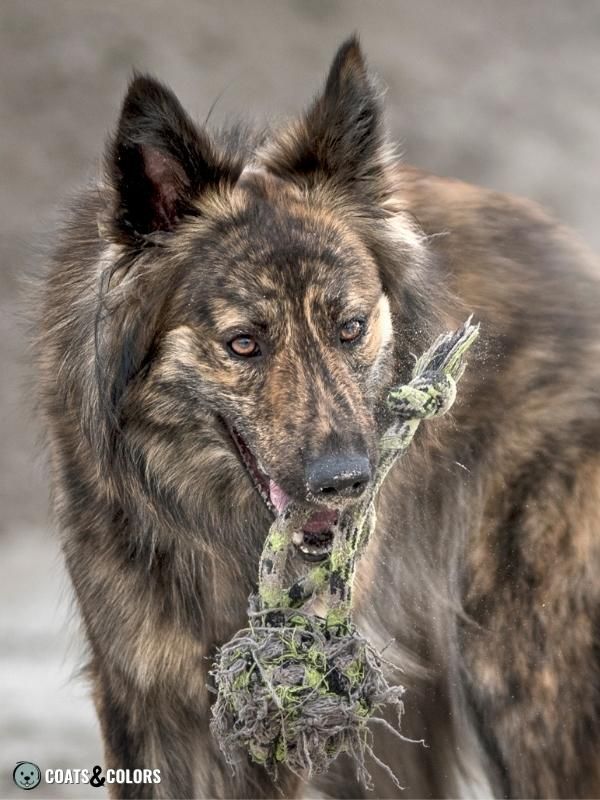
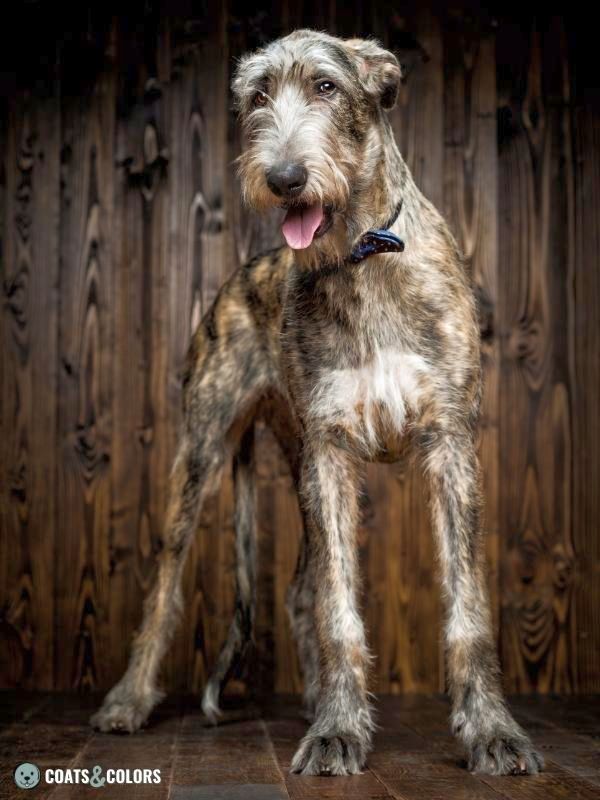
Sable Brindle
The most basic brindle pattern is a brindled sable.
Sables have a yellow coat all over the body with varying amounts of dark sabling. This shading can get quite dark on long-haired dogs which may obscure some of the brindle pattern.
Some of the sable pattern can be covered by white spotting or a melanistic mask. But there is plenty of space where brindle can show. This is why “full-body brindle” or just “brindle” usually means sable brindle.
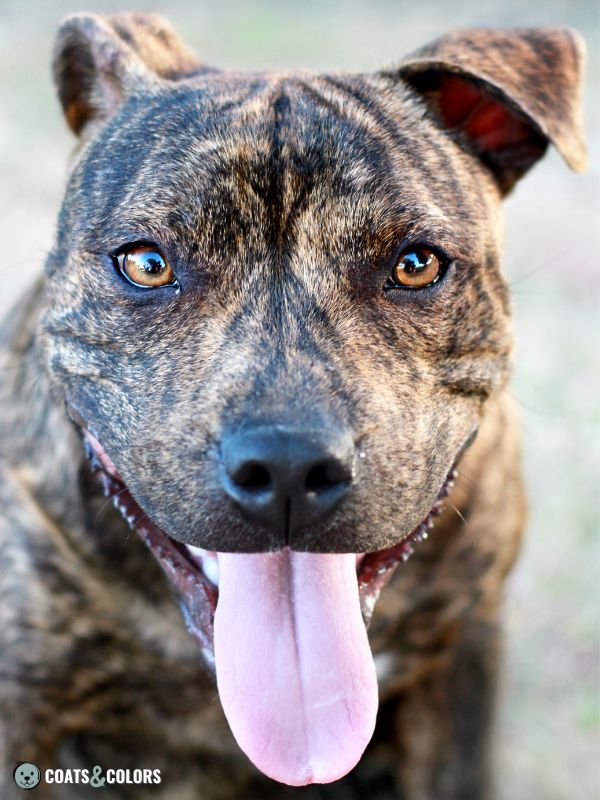
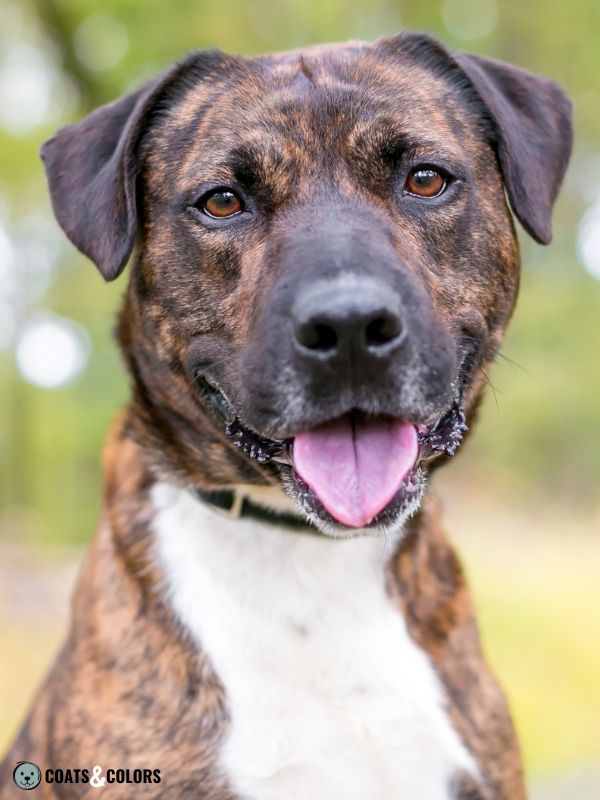
Agouti Brindle
Agouti causes alternating dark and light bands in single hairs. It often appears very grayish but can get quite dark in some dogs. The combination of agouti and brindle is not super common.
But the effect is nearly the same as in heavily shaded sables because brindle stripes become less visible or not visible at all on an already very dark coat.
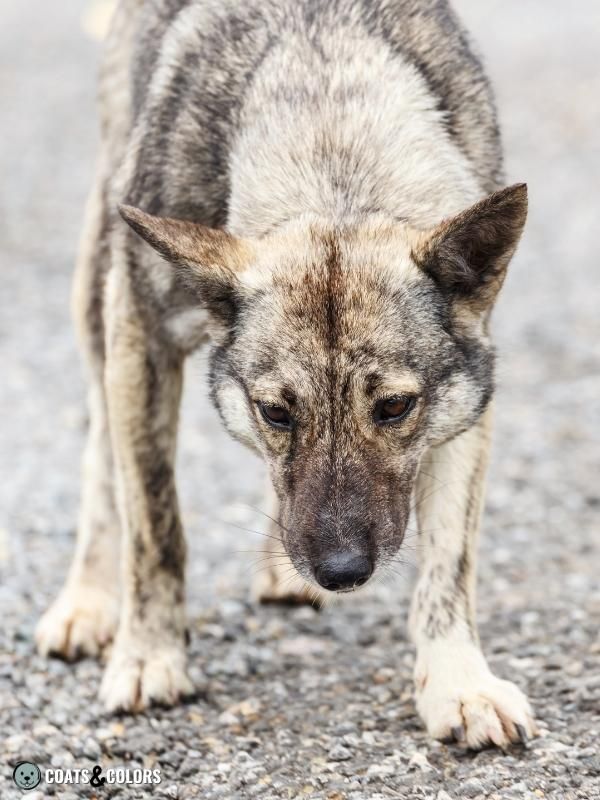
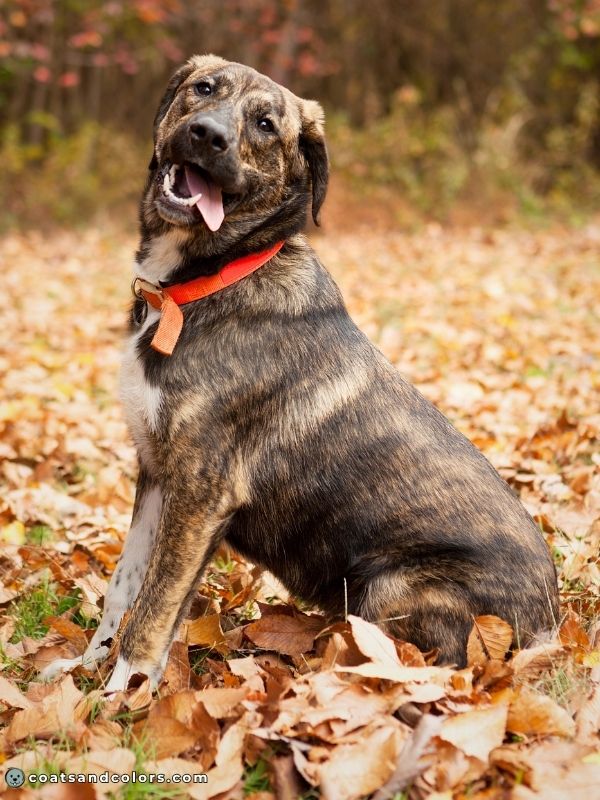
Brindle Point
In tan pointed dogs, black stripes will only be visible in the lighter tan markings.
A “brindled tan point” pattern is often called brindle point.
In dogs with already very sooty tan points, an extended dark mask, or white spotting on the face or lower legs, the tan points and thus the brindle pattern can become very small and barely visible.
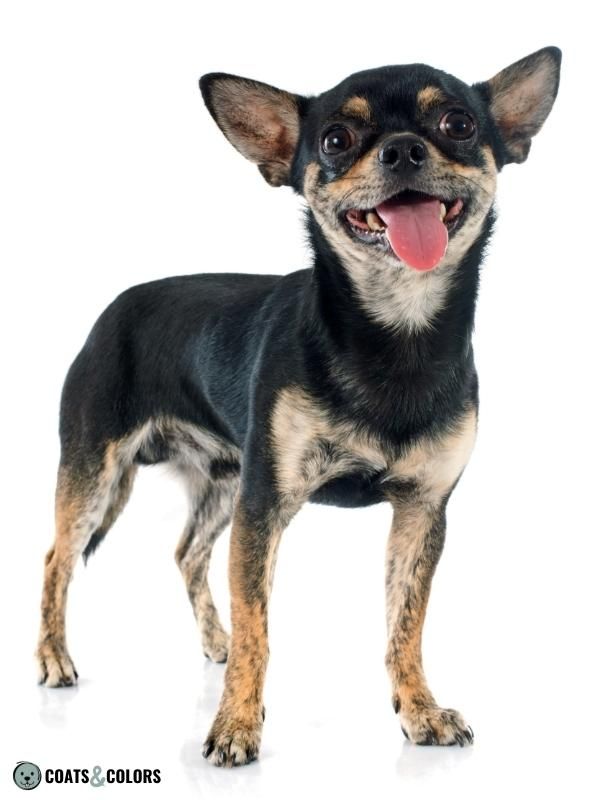
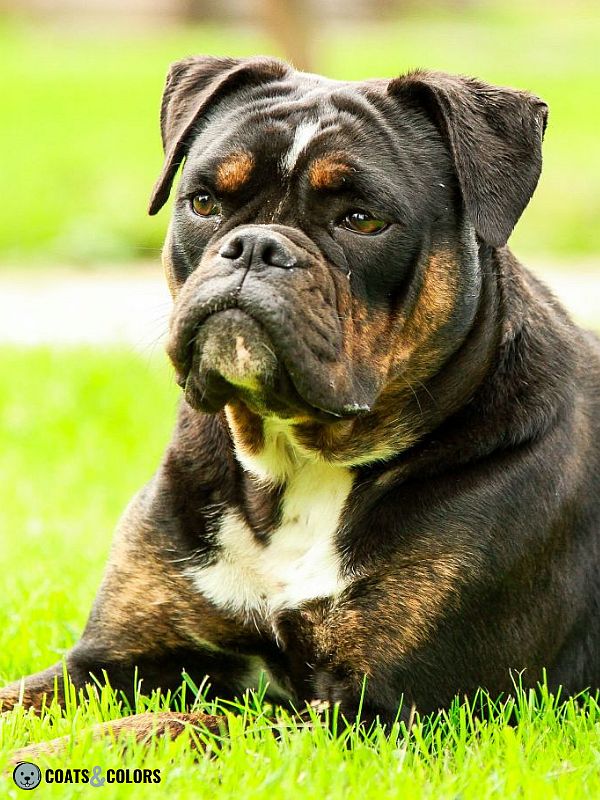
Trindle
Tan point or saddle patterns with white spotting are commonly called tricolor (e.g. a black-tricolor would be black-and-tan-and-white). Brindle will only affect the tan areas of the pattern.
The combination of brindle with white markings on a black and tan dog is sometimes called trindle (as in tricolor brindle).
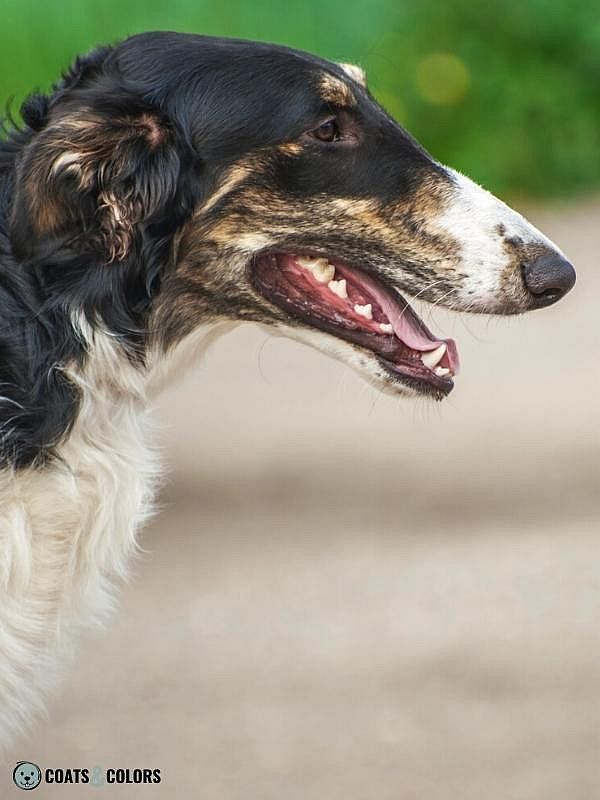
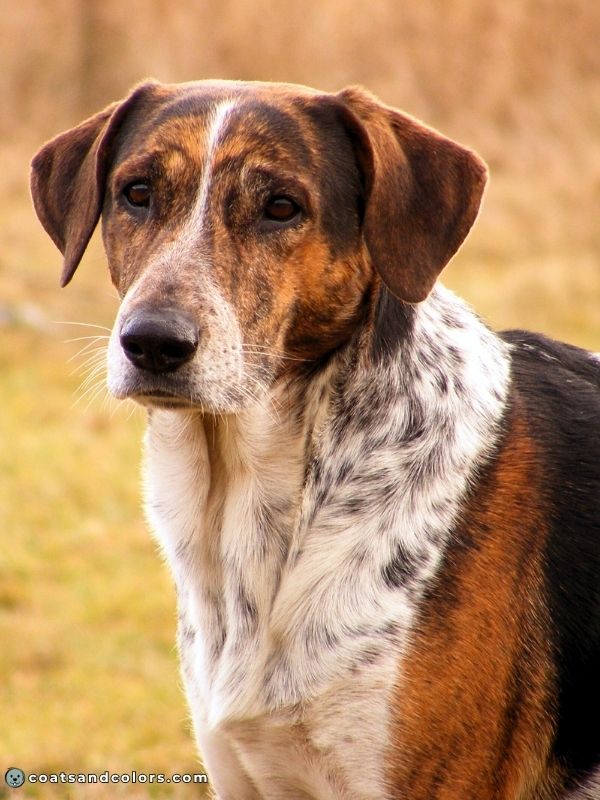
Brindled Saddle Pattern
Brindle only affects red coat. Only the lighter areas on a saddle-patterned dog get brindle stripes. The same goes for the intermediate asa/at pattern called creeping tan.
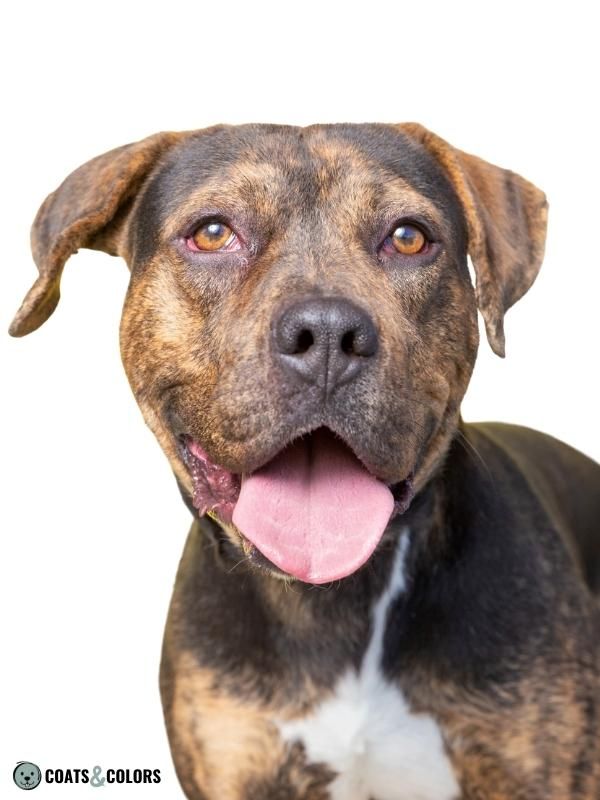
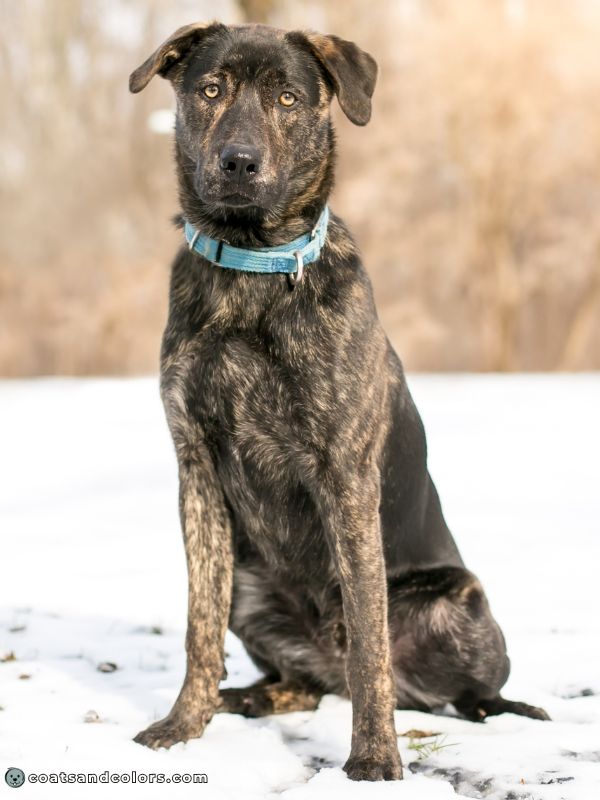
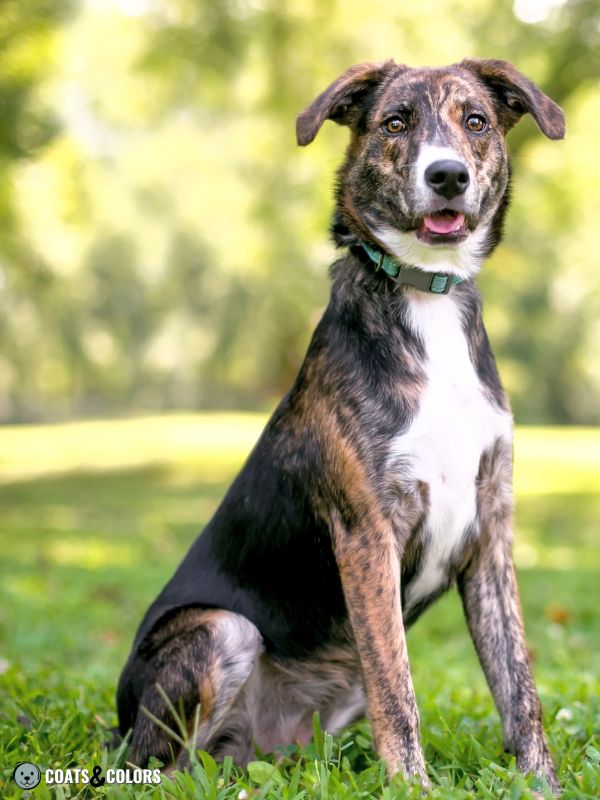
Brindle & Melanistic Masks
Brindle on the muzzle can be covered up by a melanistic mask. This is a common combination in sable brindle breeds like Boxer, Mastiff, French Bulldog, Great Dane, or Dutch Herder.
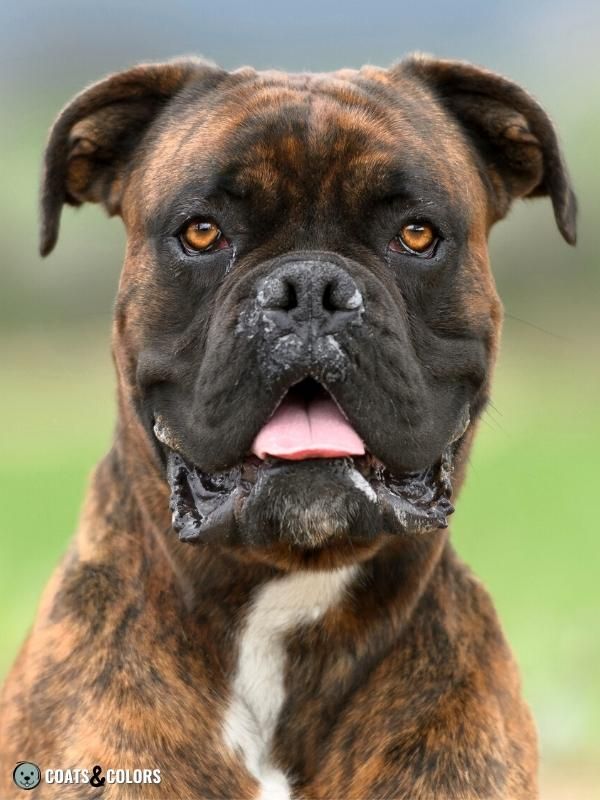
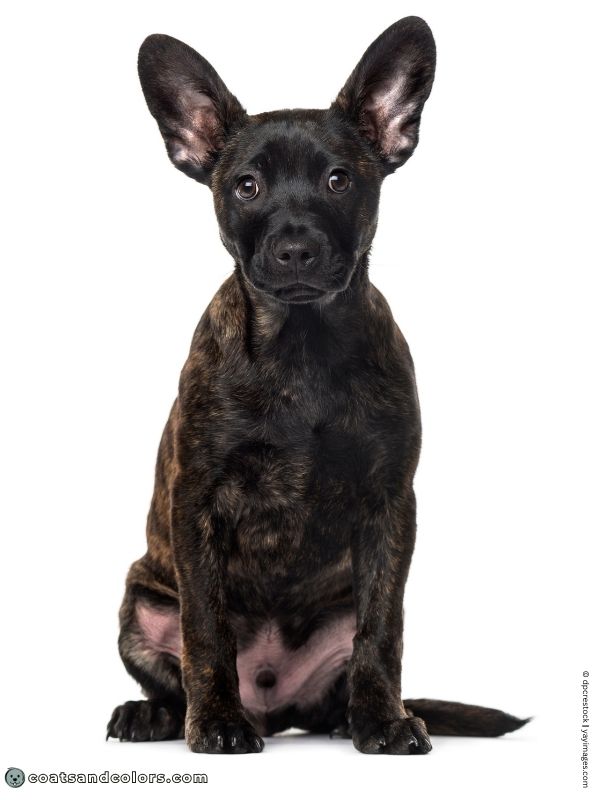
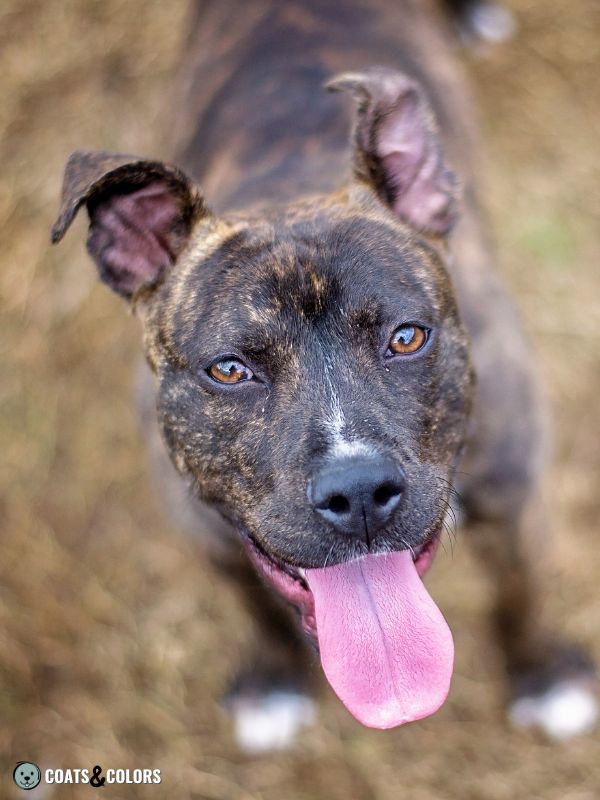
Brindle and Phaeomelanin Intensity
While most dogs have a yellow to red pigment intensity under their brindle stripes, their base color can be affected by intensity modifiers. Phaeomelanin color can actually vary from off-white to deep red.
Dogs with a very light base color are sometimes called silver brindle, cream brindle, etc.
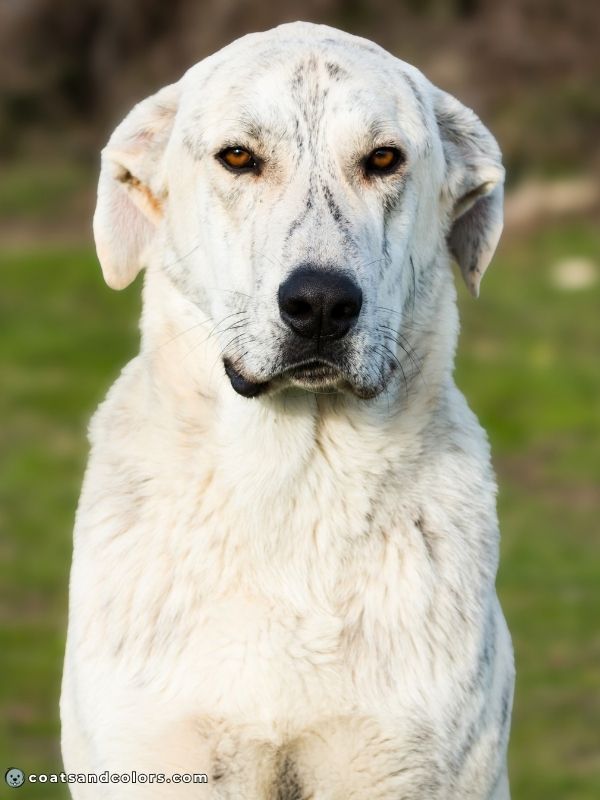
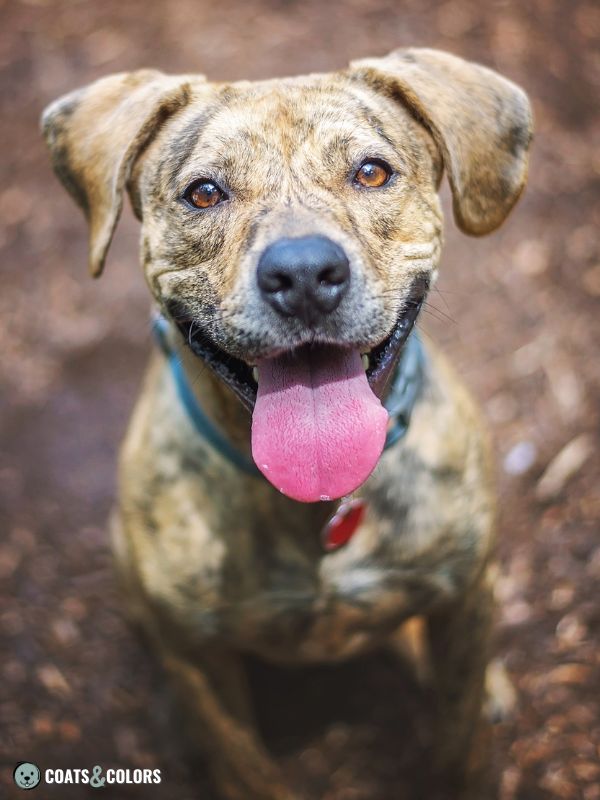
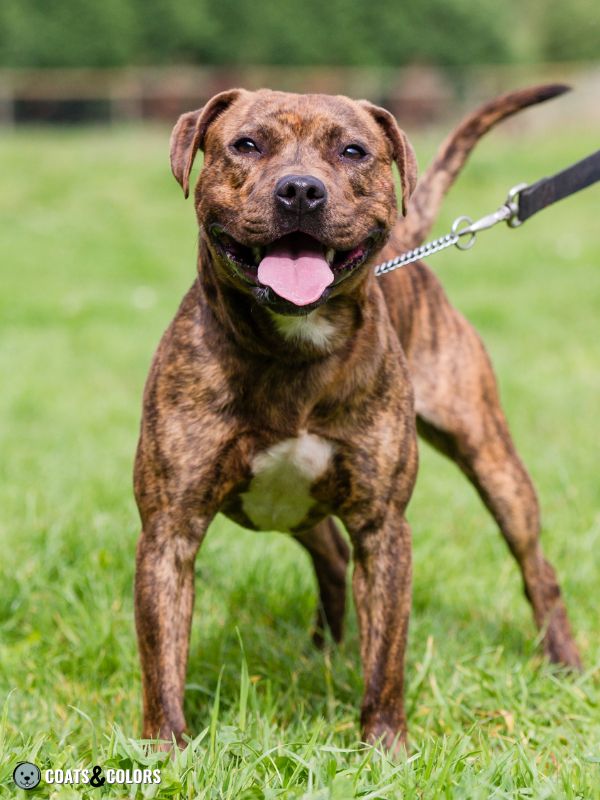
Brindle and Countershading
Sometimes only the phaeomelanin on a sable, agouti, saddle, or tan point pattern can get very light on the dog’s cheeks, eyebrows underside while keeping a normal color on the upper half of the dog.
This phenomenon is called countershading.
In brindled dogs, this causes a color transition underneath the black stripes.
In some Asian breeds, the refined version of countershading is known as urajiro. These breeds often show very crisp and bright markings instead of just a color gradient from lighter to darker coat.
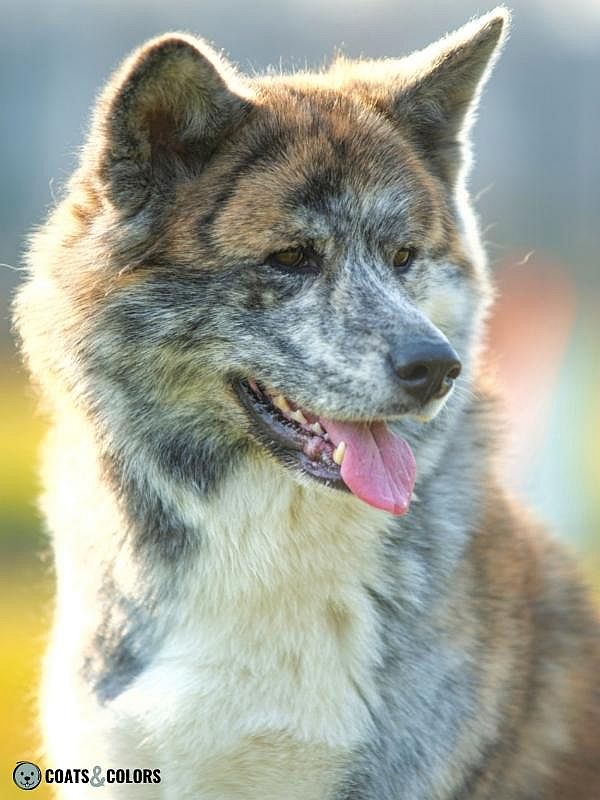
Brindle Colors
The base color of eumelanin in brindle stripes can be black, brown, blue, or lilac.
A homozygous recessive genotype at the B locus (b/b) causes brown pigment. A homozygous recessive combination at the D locus (d/d) can dilute black pigment to blue or brown pigment to lilac.
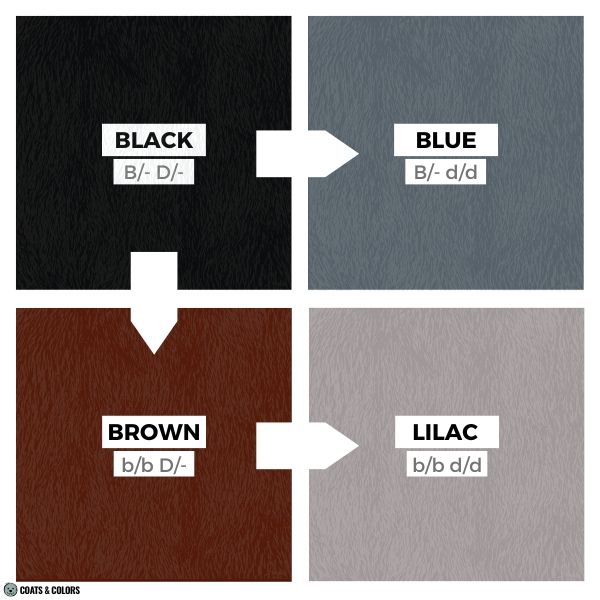
Brown Brindle
The combination of liver-colored eumelanin and brindle pattern (b/b D/-) causes the stripes to be chocolate brown. Brown stripes on a red base color don’t give as much contrast as black stripes would.
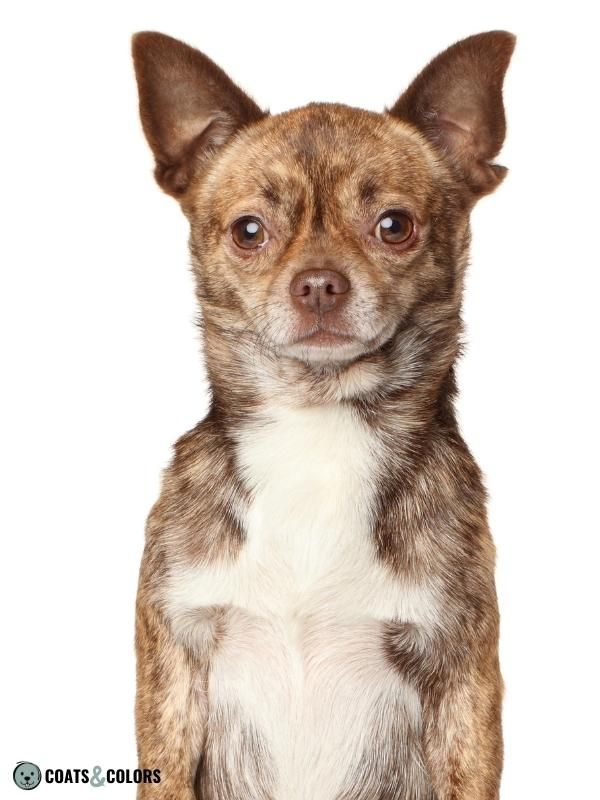
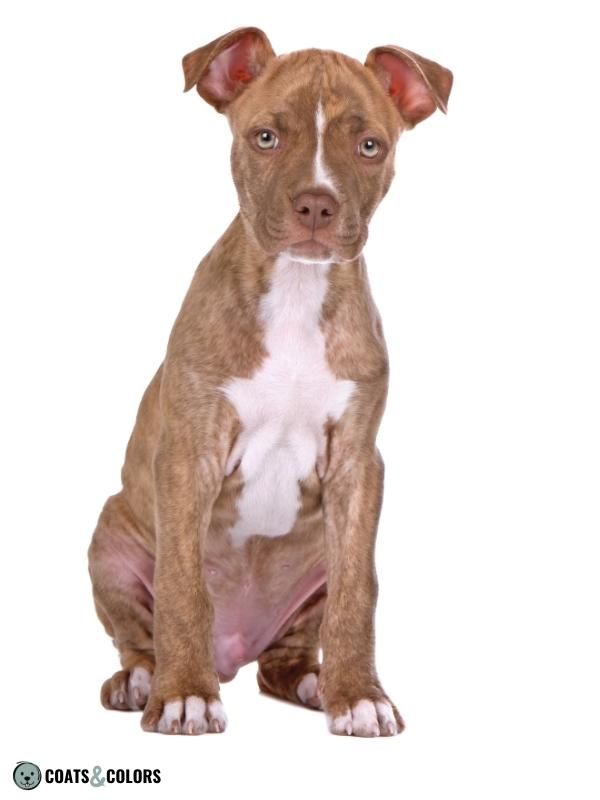
Blue Brindle
In a dog with a diluted black brindle pattern (B/- d/d), all eumelanin will turn a blue shade.
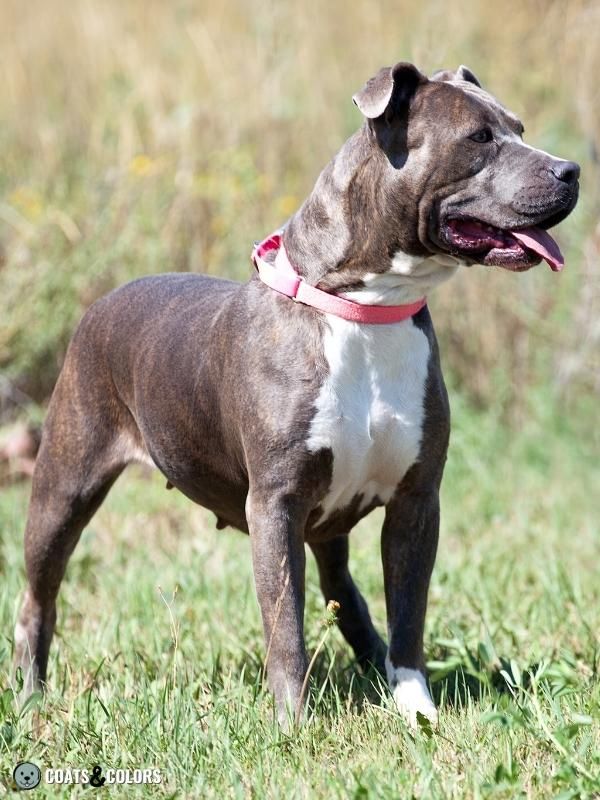
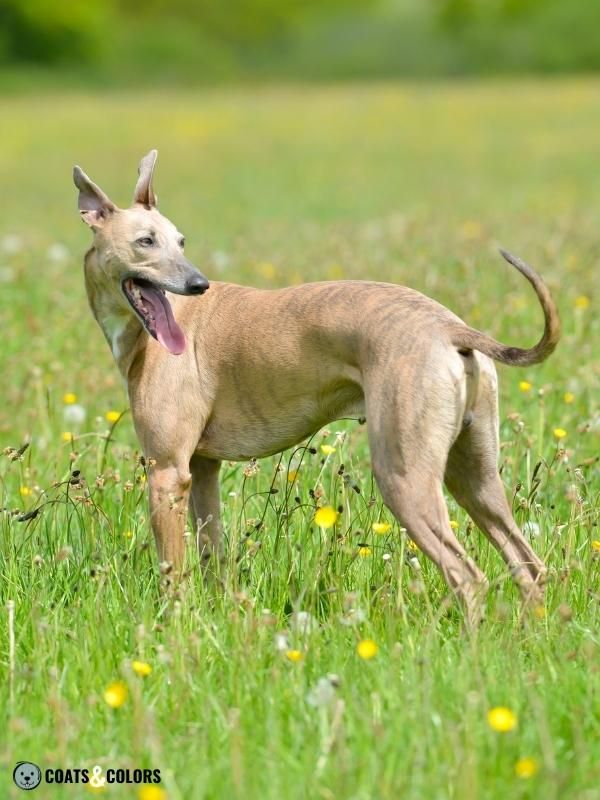
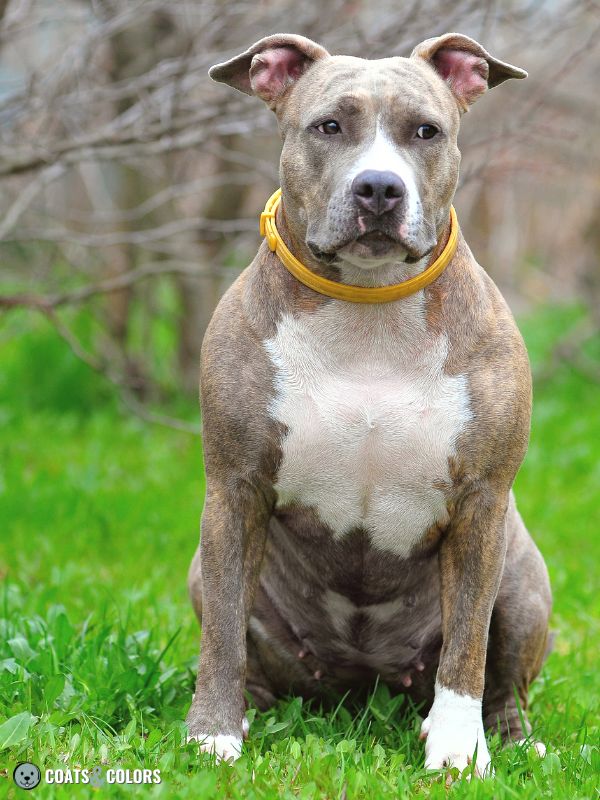
Lilac Brindle
A brown dog with pigment dilution (b/b d/d) will have lilac stripes on a red base.
This is a very rare combination and is often barely visible.
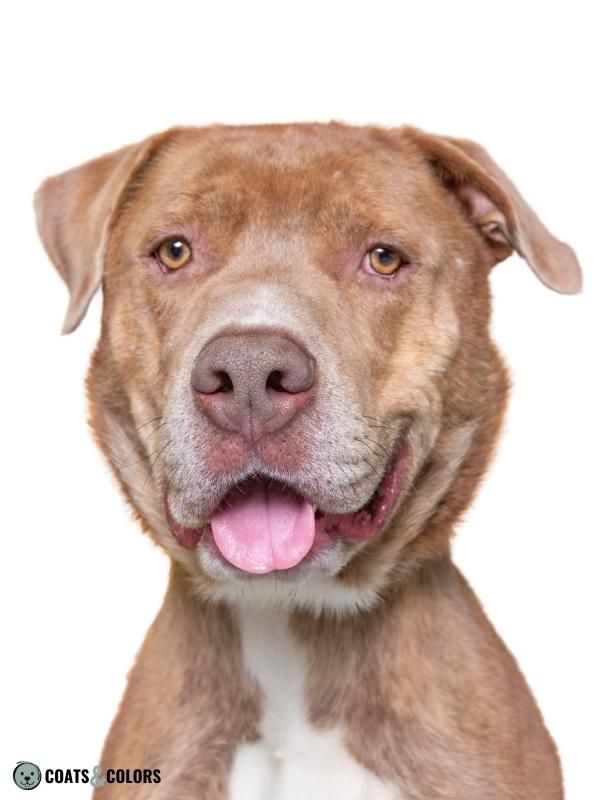
Brindle and Greying
Progressive graying causes eumelanin intensity to fade over time.
Black stripes will turn gray and brown stripes will turn beige. Since this only affects bearded dogs, it can make an already muddy brindle pattern even more washed-out.
Gray brindle can be found in the Irish Wolfhound, Scottish Deerhound, or Cairn Terrier.
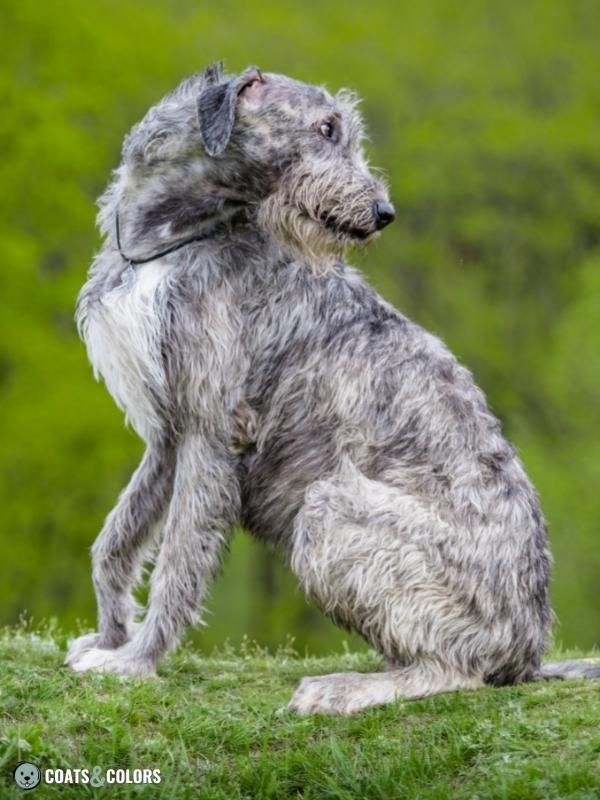
Brindle and White Spotting
White markings (from things like piebald or whitehead) are areas with a lack of pigmentation. Since neither phaeomelanin nor eumelanin is visible, the brindle will be hidden “under” the white spotting.
Many sighthounds like Whippet or Greyhound come in brindle-white. This can also be observed in the trindle pattern (tricolor and brindle) mentioned above.
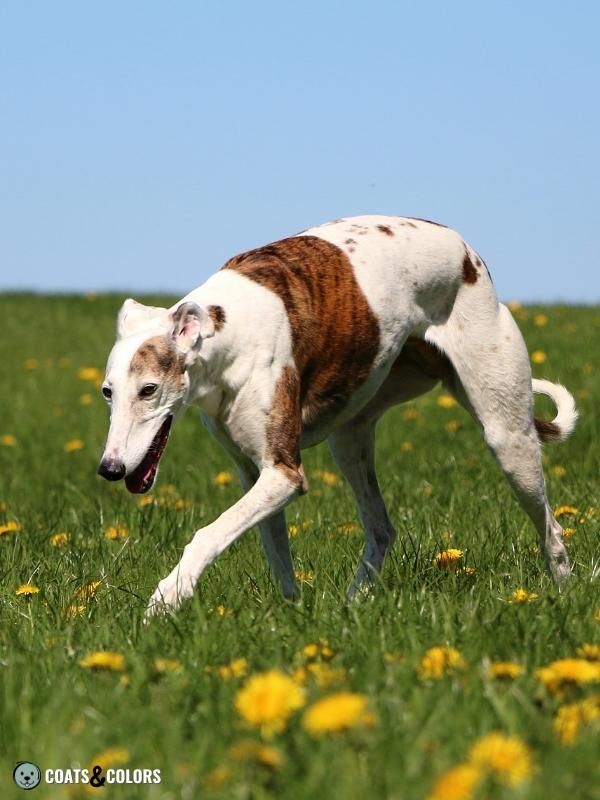
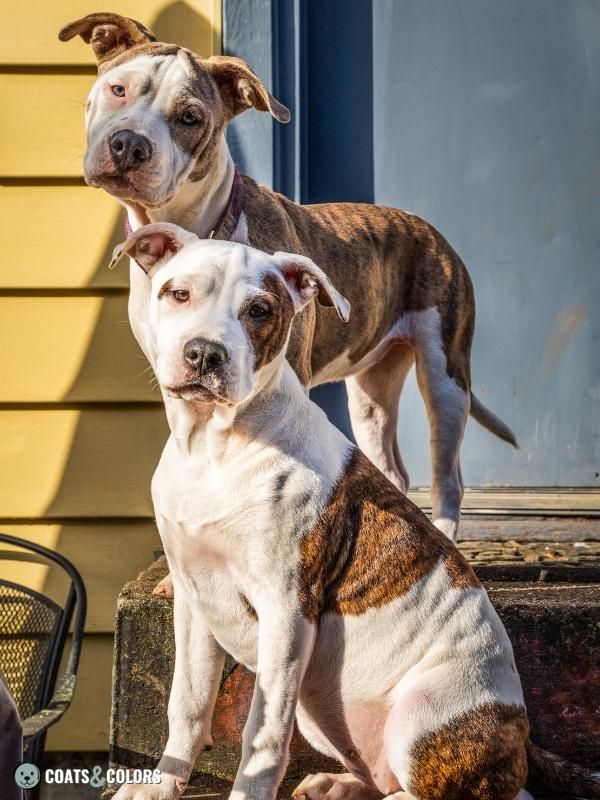
Brindle Ticking and Roan
Ticking only affects white areas of the coat. It causes pigmented dots and speckles of the original pattern. So on a brindle dog, the spots may show some brindling.
Roan happens when fully pigmented hairs grow into the white areas of the coat. Roan can get quite dense and give the impression of an almost fully pigmented coat.
The inheritance of roan and ticking is still not fully understood. Many dogs show signs of both traits with a somewhat roaned coat but individual mottles on their muzzle or legs.
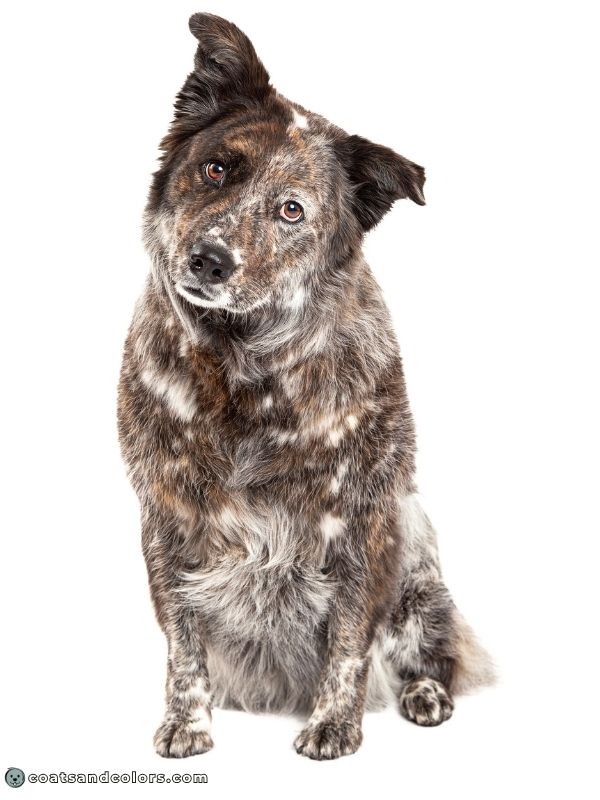
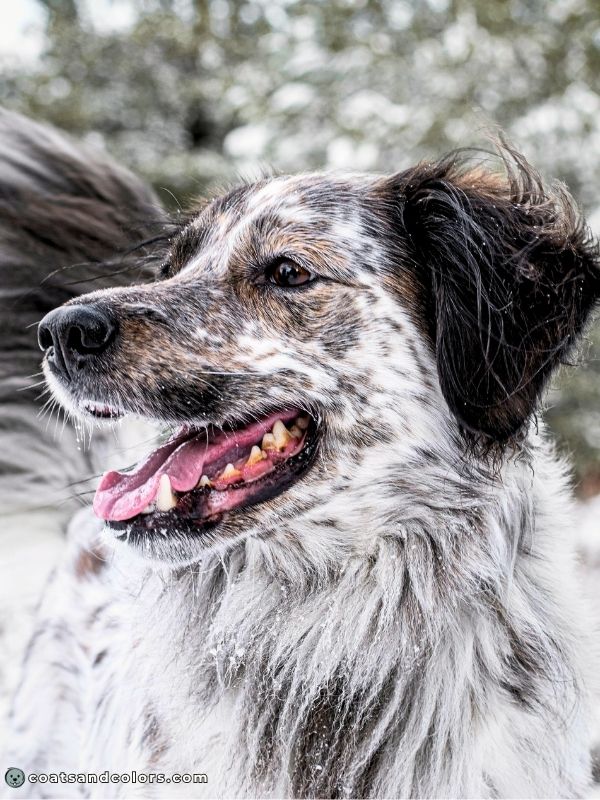
I’m still searching for more mottled or roaned dogs with a brindle pattern. This dog shows extreme white spotting with some residual colored spots on his ears (this is not real ticking):
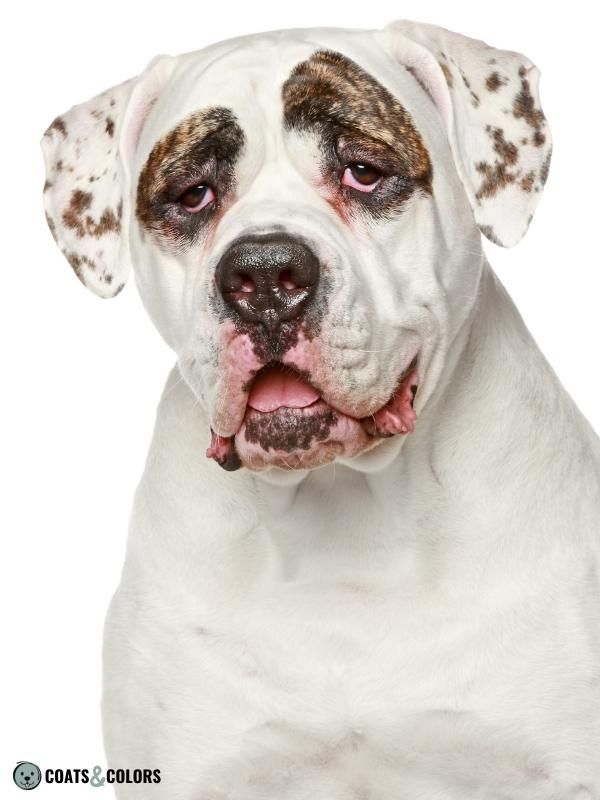
Brindle Merle
Merle deletes some of the pigment from a dog’s base pattern. While phaeomelanin is rarely affected, all the eumelanin will show a mix of still fully pigmented and diluted “merled” areas.
Merle will affect the eumelanin striping on a brindled coat. This causes the stripes on a brindle merle to look broken, patchy, or unusually irregular.
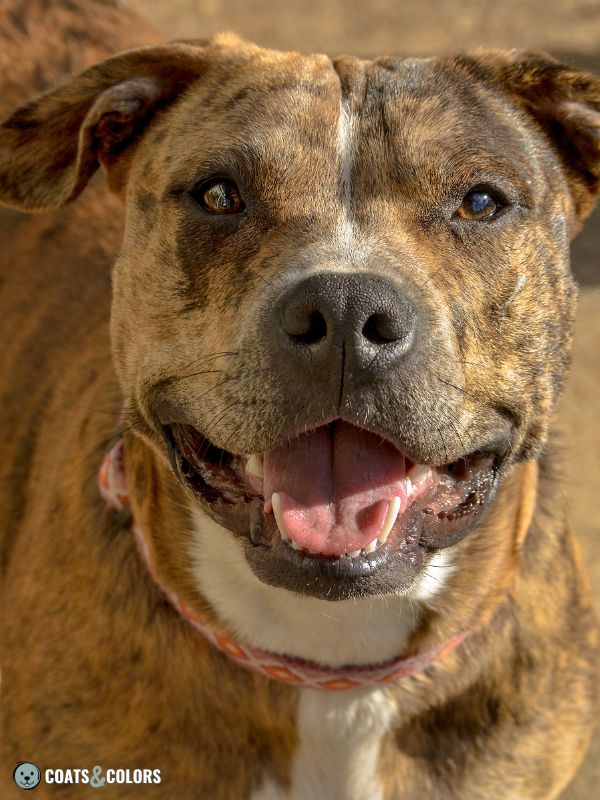
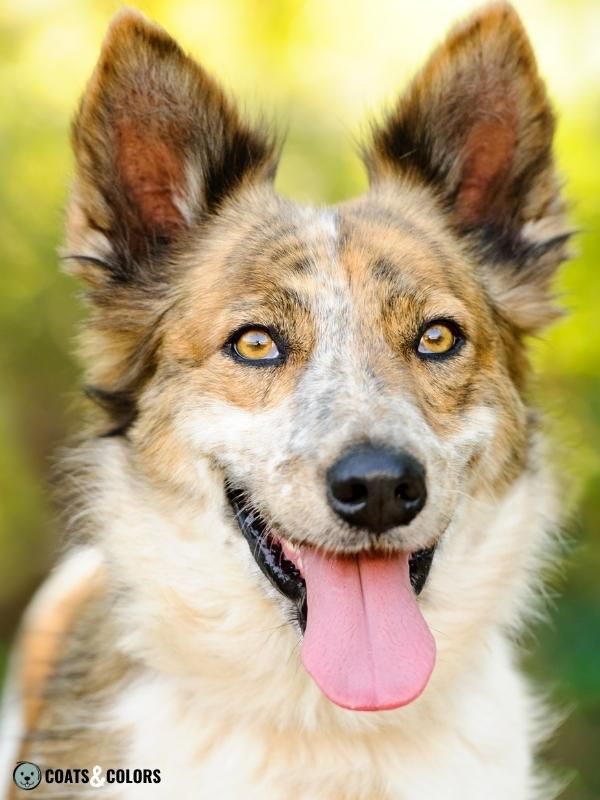
Brindlequin
Great Danes have a breed-specific merle modifier known as harlequin that only affects dogs with a merle genotype but will not be visible on non-merled Great Danes.
A H/h genotype at the H locus will cause all diluted areas in a merle coat to be fully deleted to white. This gives a distinct pattern with fully pigmented patches on a white coat.
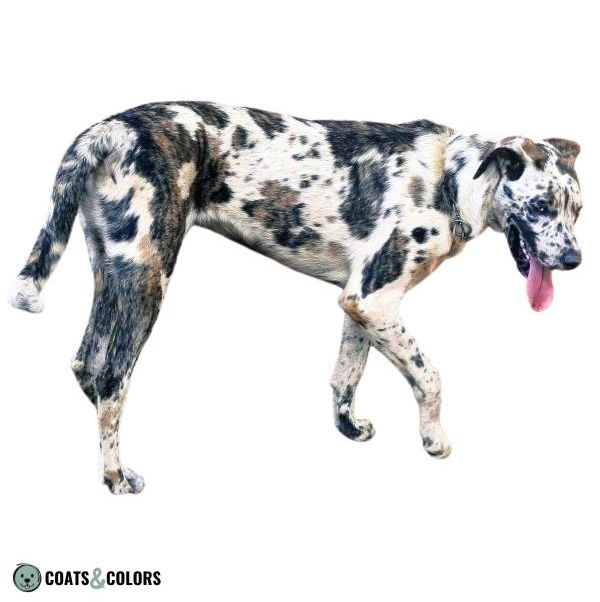
The only desired harlequin color is black and white so most breeders try to plan accordingly.
But harlequin absolutely works on sable merle or brindle merle coats. These phenotypes are typically dubbed fawnequin or brindlequin and can give quite interesting patchy patterns.
Brindle Seal
The yet to be identified seal modifier turns any eumelanin added by the K locus “transparent”. It can affect the solid dark coat in KB/- dogs as well as the black stripes in kbr/- dogs.
This way, the yellow areas of the hidden A locus pattern can show the black.
Areas with “incomplete black brindling” in kbr/- dogs can get a very brownish or reddish undertone. Typically, the black pigment remains strongest along the topline and lower legs.
Affected dogs often have amore subtle reddish brindle pattern. Brindle seal occasionally seems to happen in breeds like Boxers, Staffies, Boston Terriers, or Catahoula Leopard Dogs.
There are also some rare cases known of “ghost brindle” expressing on KB/kbr dogs with a seal phenotype.
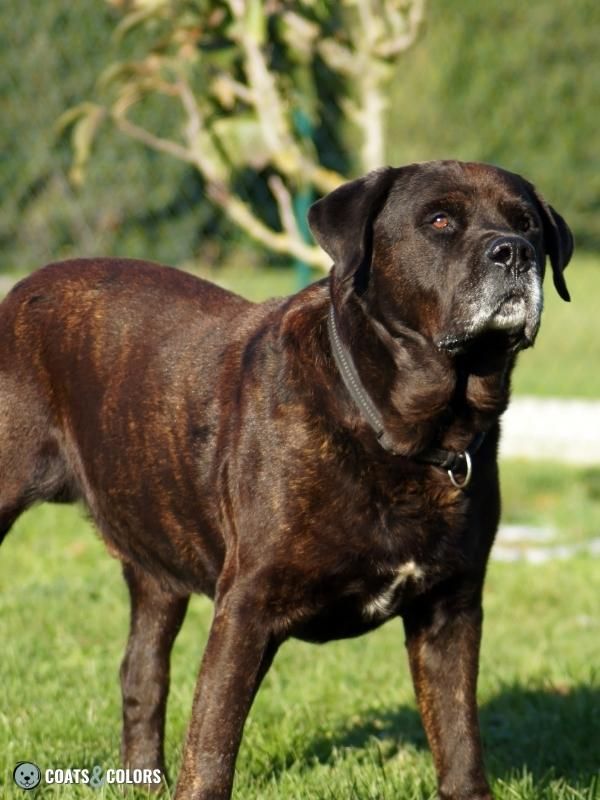
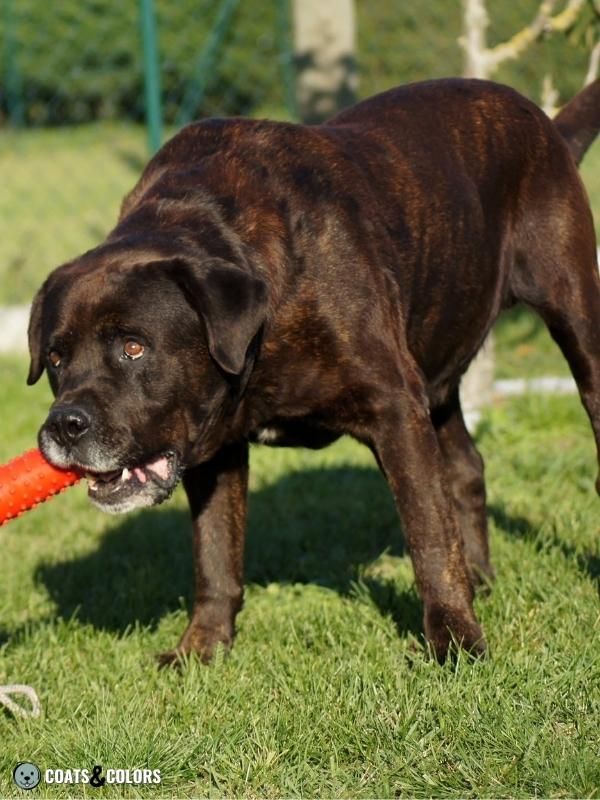
Brindle Domino
Domino is most often found in northern breeds (eA) or sigthound breeds (eG) where it modifies the original pattern a dog would have had.
Domino restricts eumelanin production. It can shrink areas with eumelanin from a pattern (e.g. it can give pale open “Husky face markings” in dogs that should be black & tan).
Domino can also cause a pale phaeomelanin intensity or gives lighter hair roots and undercoat.
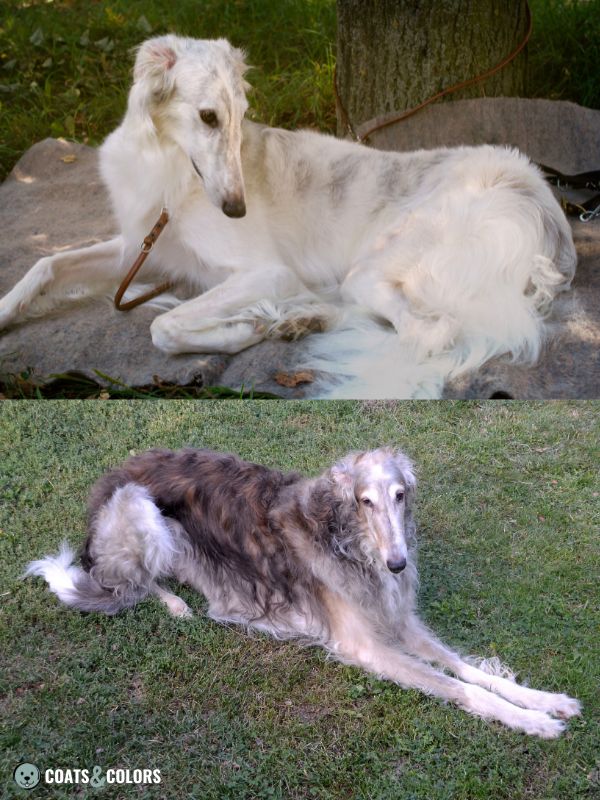
Brindle with domino is quite rare and mostly happens in sighthounds like Afghan Hounds or Borzoi where it can do some interesting things.
But the expression of domino can vary greatly between dogs.
A domino brindle pattern can sometimes just have very reduced and grayish brindle. It can also shrink the extension of brindle and remove brindle from the extremities and face.
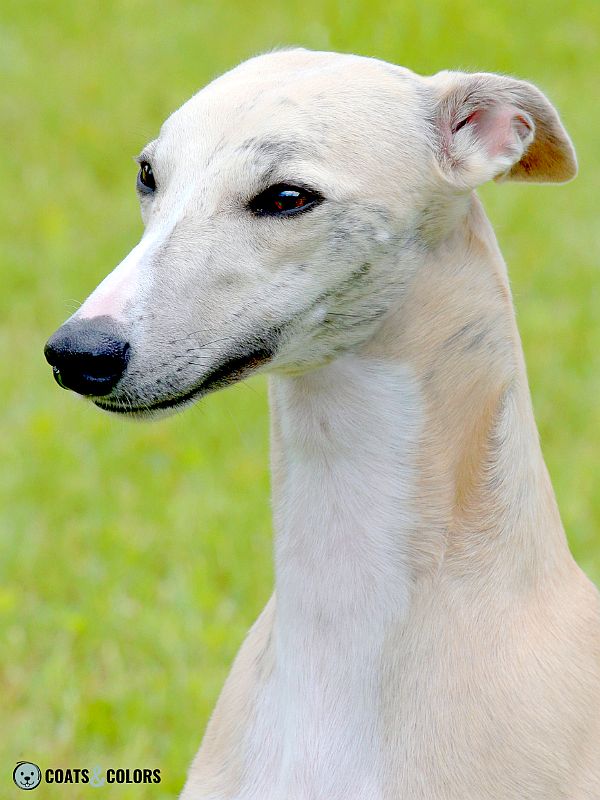
Dog Breeds with Brindle
Brindle is a very common pattern in many dog breeds. In some of them it’s a very popular pattern (e.g. Boxer, Dutch Shepherd Dog), in others it’s quite rare (e.g. Border Collie):
- Afghan Hound
- American Akita
- Akita Inu
- American Bulldog
- American Staffordshire Terrier
- Azawakh
- Basenji
- Border Collie
- Borzoi
- Boston Terrier
- Bouvier des Ardennes
- Bouvier des Flandres
- Boxer
- Bullmastiff
- Bull Terrier
- Ca de Bou
- Cairn Terrier
- Cane Corso
- Cão de Castro Laboreiro
- Chihuahua
- Cimarrón Uruguayo
- Dachshund
- Dutch Shepherd Dog
- English Bulldog
- Fila Brasileiro
- French Bulldog
- Galgo Español
- Great Dane
- Greyhound
- Hanoverian Scent Hound
- Irish Glen of Imaal Terrier
- Irish Wolfhound
- Presa Canario
- Kai Ken
- Miniature Bull Terrier
- Neapolitan Mastiff
- Pyrenean Shepherd
- Scottish Deerhound
- Scottish Terrier
- Segugio Maremmano
- Sloughi
- Staffordshire Bull Terrier
- Taiwan Dog
- Welsh Corgi Cardigan
- Whippet
Learn More
Links
[1] Julie A Kerns, Edward J Cargill, Leigh Anne Clark, Sophie I Candille, Tom G Berryere, Michael Olivier, George Lust, Rory J Todhunter, Sheila M Schmutz, Keith E Murphy, Gregory S Barsh. Linkage and Segregation Analysis of Black and Brindle Coat Color in Domestic Dogs. Genetics, Volume 176, Issue 3, 1 July 2007, Pages 1679–1689, https://doi.org/10.1534/genetics.107.074237
[2] S. M. Schmutz, T. G. Berryere, N. M. Ellinwood, J. A. Kerns, G. S. Barsh. MC1R Studies in Dogs With Melanistic Mask or Brindle Patterns. Journal of Heredity, Volume 94, Issue 1, January 2003, Pages 69–73. https://doi.org/10.1093/jhered/esg014
[3] Dreger DL, Anderson H, Donner J, Clark JA, Dykstra A, Hughes AM, Ekenstedt KJ. Atypical Genotypes for Canine Agouti Signaling Protein Suggest Novel Chromosomal Rearrangement. Genes (Basel). 2020 Jul 3;11(7):739. doi: 10.3390/genes11070739. PMID: 32635139; PMCID: PMC7397341.
Image Credits
© dpcrestock/yayimages.com
© magann/yayimages.com
© Azaliya/canva.com
© Alberto Calleja/pexels.com
© dageldog/canva.com
© Mary Swift/canva.com
© virgonira/canva.com
© Gelpi/canva.com
© Julie Weiss/canva.com
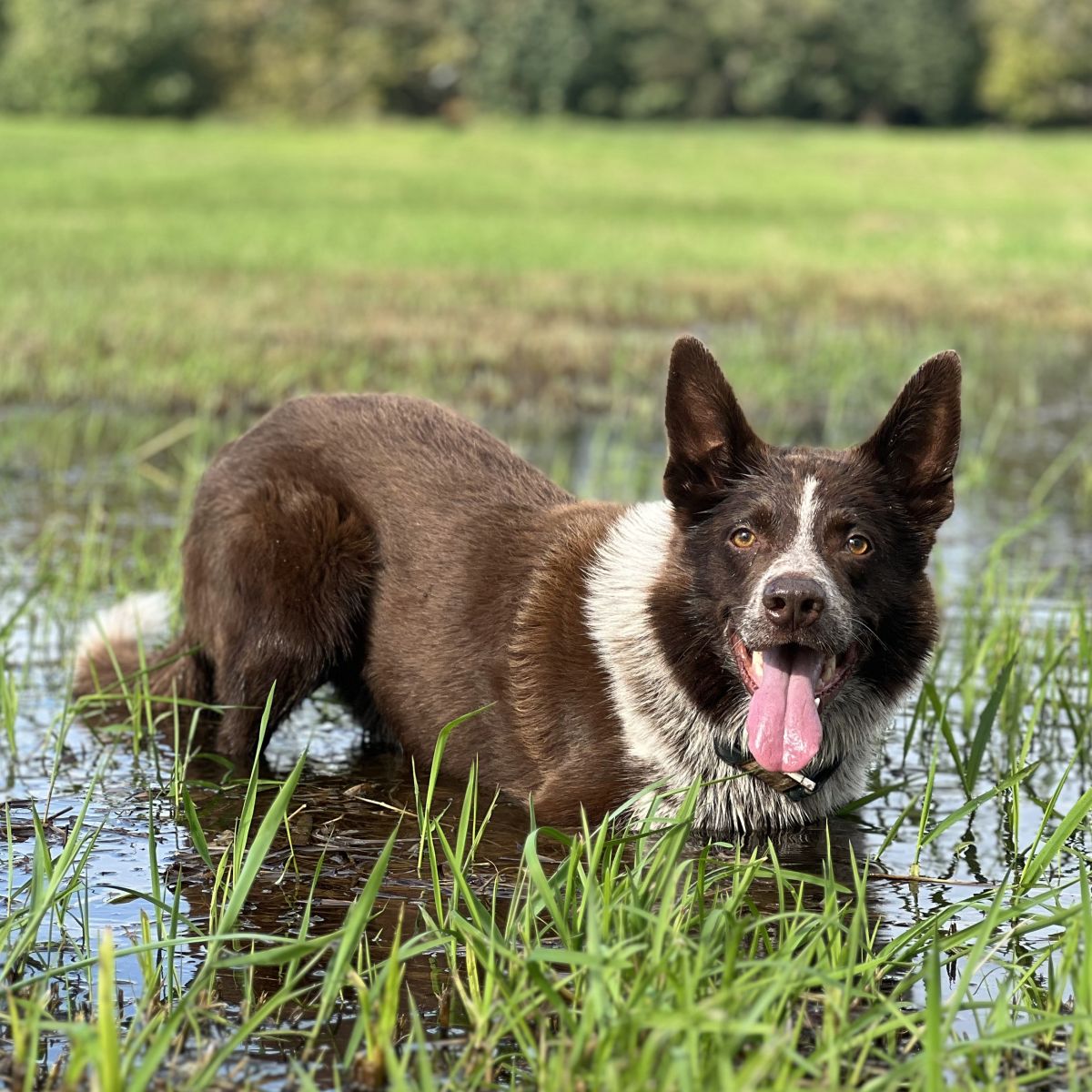
Hi! I’m Steffi. I am a biologist and a big time dog nerd. You are curious about coat color genetics? You’ve come to the right place! Read more.

